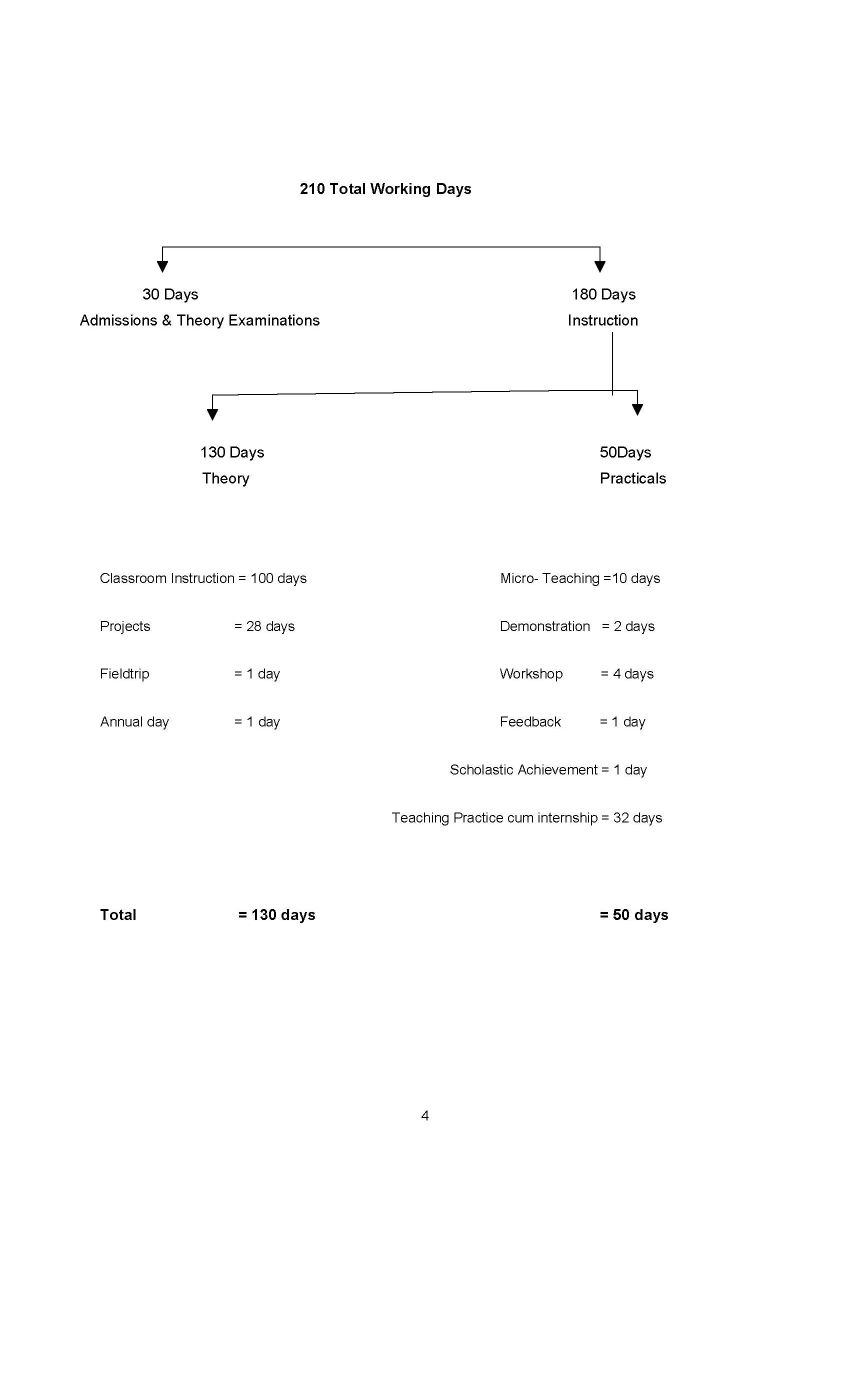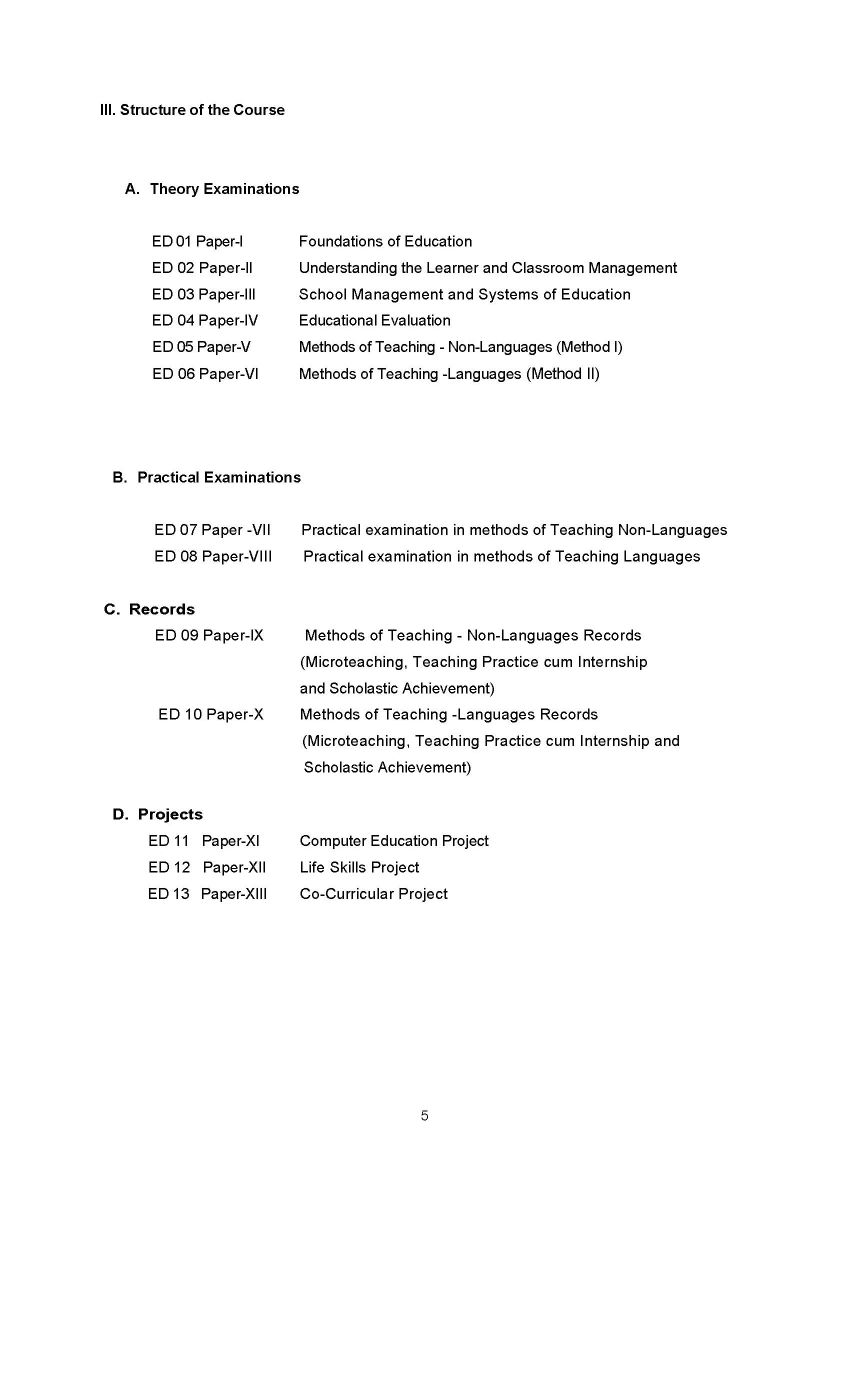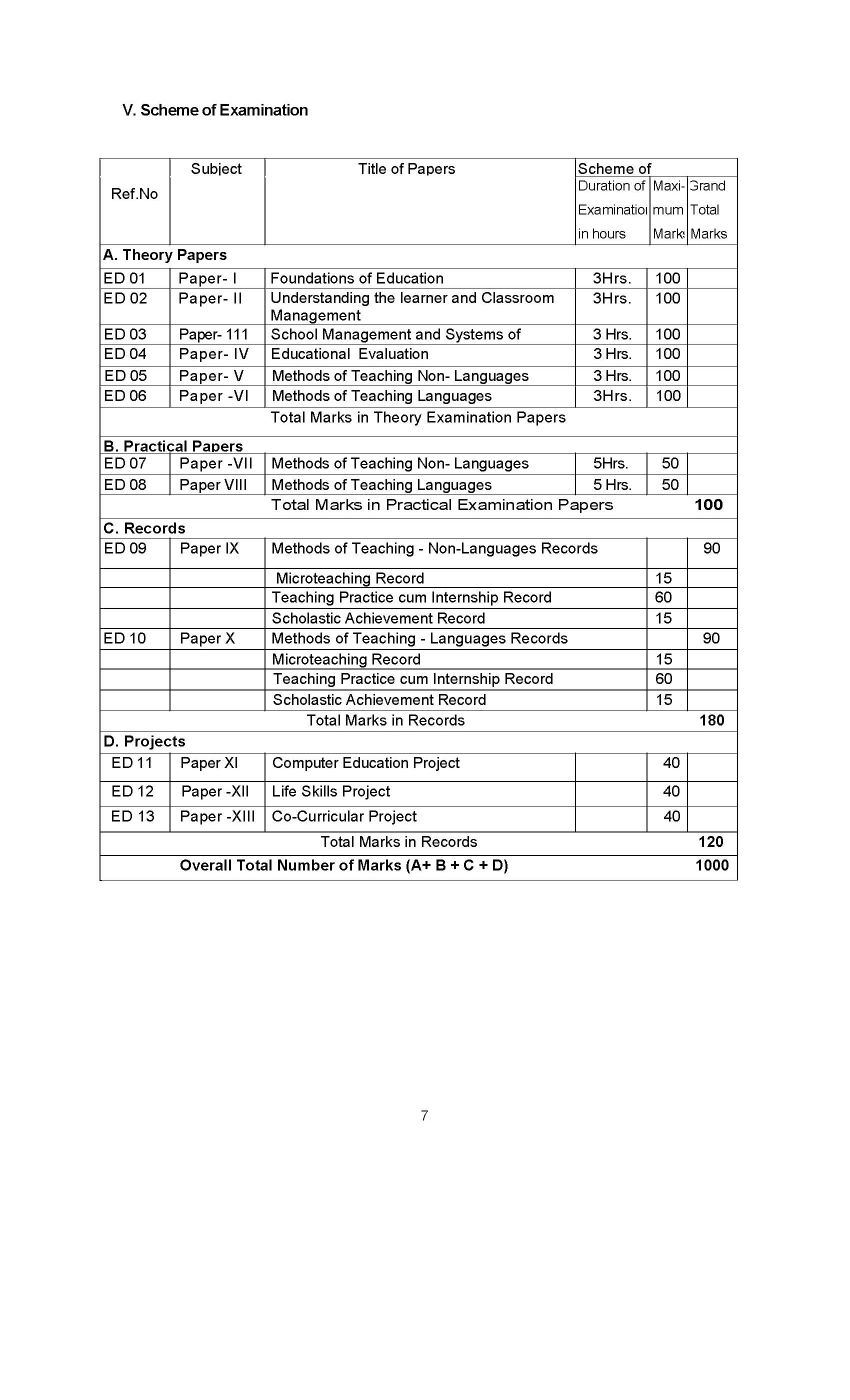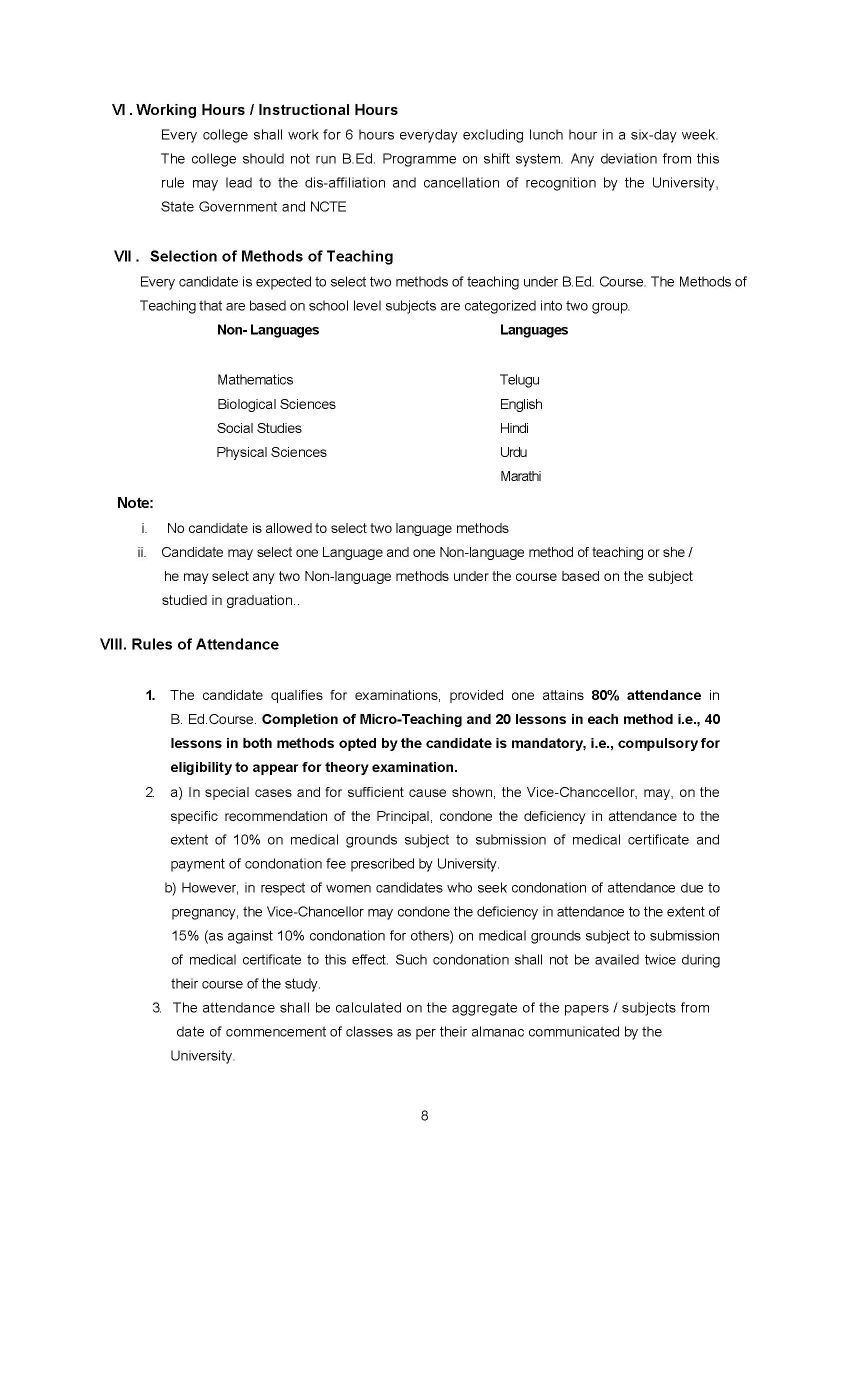| Re: B.Ed Biological Science Syllabus in AP
A Common Entrance Test, designated as AP Education Common Entrance Test (APEd.CET) is conducted by the Convener, APEd.CET, Sri Venkateswara University, Tirupati on behalf of the Andhra Pradesh State Council of Higher Education for admission in to B.Ed (2 years) Regular Course in the Colleges of Education in Andhra Pradesh State.
Syllabus for the subjects under Part-A and Part-B of the Education Common Entrance Test - 2015
B.Ed Syllabus in AP
PART - A: GENERAL ENGLISH
(Marks: 25)
1. Reading Comprehension.
2. Correction of Sentences, Articles, Prepositions, Tenses, Spelling.
3. Vocabulary, Synonyms, Antonyms.
4. Transformation of Sentences - Simple, Compound and Complex. Voices, Direct Speech and Indirect Speech.
PART - B: GENERAL KNOWLEDGE & TEACHING APTITUDE
(Marks: 15+10)=25
1. Questions will be designed to test the ability of the candidate's general knowledge of the environment around him and its application to society.
2. Questions will also be designed to test knowledge of current events and of such matters of every day observation and experience in their scientific outlook as is expected of an educated person.
3. The test will also include questions relating to India and its neighbouring Countries especially pertaining to History, Culture, Geography, Ecology, Economics, General Policy and Scientific Research.
4. Teaching requires certain characteristics like ability to communicate, ability to deal with Children, ability to recognise individual differences etc., apart from analytical thinking and general intelligence. One who has these characteristics will be able to become a good teacher after training. Questions relating to these aspects will be included to test one's teaching aptitude.
Part –C
MATHEMATICS (Marks: 100)
(SYLLABUS)
1. Sets - relations - binary operations - semi groups - groups - subgroups -normal subgroups - homomorphism-Functions permutations permutation groups - cyclic groups - quotient group - automorphism.
2. Rings - Integral domains - fields - characteristic - homomorphism - Ideals - Prime Ideals - maximal ideals - Rings of permutations - polynomials - polynomial rings.
3. Vector spaces - linearly independent vectors - Basis - dimension - linear transformation -- Null space -- Range -- Rank of a linear transformation.
4. Elementary matrix operations - Elementary matrices – Determinants - properties - rank of matrix - inverse of a matrix - Eigen vectors - Eigen values - systems of linear equations.
5. Three dimensional geometry -- Coordinates -- distance formula - direction cosines - plane - angle between two planes – perpendicular distance from a point - Equation of a line - skew lines – shortest distance - The sphere - tangent plane power of a point - polar plane and pole - radical plane - coaxial system of spheres - The circle - radius - centre.
6. Real numbers - properties - functions - range - sequences - series - limits - continuity - differentiability - differentiation - mean value theorems -- L'Hospital rules -- Integration definite integrals - Reimann integral.
7. Differential equations - first order and first degree - different forms – Exact differential equations - change of variables - equation of first order but not of first degree - higher order linear differential equations - system of linear differential equations.
8. Elements of Number theory - Divisibility - primes - congruences - solutions of congruences - congruences of degree 1 The Euler function O.
- Quadratic equations - quadratic expressions - change of sign – roots maximum - minimum values
Part – C
PHYSICAL SCIENCE:
PHYSICS (Marks: 50)
(SYLLABUS)
1. Vector Analysis: Scalar and Vector fields, Gradient of a scalar field. Divergence and curl of a vector field
2. Mechanics of particles: Laws of motion, Motion of variable mass system. Conservation of energy and momentum.
3. Mechanics of Rigid bodies: Definition of Rigid body, rotational kinematics relations, equation of motion for a rotating body, angular momentum. Eulers equation, precession of a top.
4. Central forces: Central forces - definition and examples, Conservative nature of central forces. Equation of motion under a central force, Gravitational field, motion under inverse square law, derivation of Kepler's laws.
5. Fundamentals of vibrations: Simple harmonic oscillator and solution of the differential equation-physical characteristics of SHM, frequency of loaded spring taking its mass into consideration.
6. Damped and forced oscillations: Damped harmonic oscillator, solution of the differential equation of damped oscillator. Energy consideration, comparison with undamped harmonic oscillator.
7. Vibrating strings: Transverse wave propagation along a stretched string, general solution of wave equation and its significance, modes of vibration of stretched string clamped at both the ends, overtones.
8. Kinetic theory of gases: Deduction of Max Well's law of distribution of molecular speeds - Transport phenomena - Viscosity, thermal conduction and diffusion of gases.
9. Thermodynamics: Heat and work - Internal energy - Indicator Diagrams work done is Isothermal and adiabatic processes - First law of thermodynamic - significance and applications of first law of thermodynamics – Reversible and irreversible process - Carnot's theorem - Carnot's engine, efficiency - Clausius - Clapeyron equation - Second law of thermodynamics, different statements - Thermodynamic scale of temperature-Entropy concept - Entropy and disorder measurement of entropy changes in reversible and irreversible processes - Entropy of universe - Entropy - Temperature diagrams,
10. Quantum theory of Radiation: Block body Fery's black body distribution of energy in the spectrum of a black body - Wien's displacement law, Wien's law; Raleigh Jean law - Quantum theory of radiation - Planck's law deduction of Wien's law, Releigh Jeans law Wien's displacement from Planck's law.
11. Statistical thermodynamics: Introduction of statistical mechanics - statistical equilibrium - probability theorems in statistical thermodynamics - Max Well - Boltzmann distribution law (Statement and expression only) - Application to ideal gas. Quantum Statistics - Phase space - Fermi - Dirac distribution law (statement and expression only) - Application to electron gas
- Bose -- Einstein distribution law (statement and expression only) - application to photon gas - comparison of three statistics.
12. Interference: The superposition principle - coherence - temporal and spatial conditions for interference of light. Interference by division of wave front - Fresnel's bipism - determination of wavelength of light chance of phase on reflection - determination of thickness of a transparent material using prism. Interference by division of amplitude - oblique incidence of a plane wave on a thin film (the cosine law) - coloures of thin films - non reflecting thin films - interference by a plane parallel film illuminated by a point surface - interference by film with two non parallel reflecting surfaces (wedge shaped film)-determination of diameter of wire Newton's rings in reflected and transmitted light. Determination of wavelength of monochromatic light Michelson Interferometer, types of fringes, determination of wavelength of monochromatic light, thickness of a thin plate.
13. Diffraction: Fraunhofer diffraction - diffraction due to a single slit and circular aperture. Limit of resolution - two-slit Fraunhofer diffraction - Fraunhofer diffraction pattern with N-slits - The Fourier transform and its properties - the shifting theorem and application of the FT to Fourier diffraction due to single slit, A double slit and the diffraction grating - The diffraction grating normal and oblique incidence determination of wavelength of light.
14. Polarization and double effraction: Polarized light - Brewsters law - Malus Law - phenomenon of double refraction is calcite - Refraction of plane wave icident on a negative crystal like calcite - Nichol prism. Analysis of polarized light by quarter wave plate - Babinet compensator.
15. Lasers fiber optics and Holography: Spontaneous, stimulated emission – Laser principle - population inversion - Einstein coefficients - Types of lasers, He - and New Ruby lasers and the application of lasers.
16. Electrostatics: Gauss law and its applications, electric field due to an infinite conducting sheet of chare, uniformly charged sphere and charged cylindrical conductors, mechanical force on a charged conduct, electric potential, potential due to charged spherical conductor, and electric dipole and an infinite line of charge.
17. Dielectrics: An atomic view, potential energy of a dipole in an electric field, polarization and charge density, dielectrics and Gauss's law - Relation between D.E. and P-Dielectric constant and susceptibility, Boundary conditions at the dielectric surface.
18. Capacitance: Capacity of concentric spheres and cylindrical condenser, capacity of parallel plate condenser with and without dielectric -electric energy stored by a charged condenser - force between plates of condenser, attracted disc electrometer construction and working.
19. Magnetostatics: Magnetic shall-potential due to magnetic shell - field due magnetic shell - equivalent of electron circuit and magnetic shell - application of field due to magnetic shell - magnetic induction (B) and field (H) - Permeability and susceptibility - Hysteresis loop.
20. Moving charge in electric and magnetic fields: Hall effect, cyclotron, synchrocyclotron and synochrotron - force on a current carrying conductor, force and torque on current loop - Biot Severt's law and calculation of B due to long straight wire, circular a current loop and solenoid.
21. Electromagnetic induction: Faraday's law - Lenz's law - expression for induced emf - electromotive force-time varying magnetic fields - Betatran - Ballistic galvanometer - theory - damping correction - self and mutual inductance, coefficient of coupling, calculation self inductance of along solenoid - toroid - energy stored in magnet in field principles of transformer.
22. Varying and alternating currents: CR circuits, LR circuits, growth and decay of currents, LCR circuit, critical damping - alternating current, relation between current and voltage in pure RC and L-vector diagrams LCR circuit power factor, series and parallel resonant circuit - Q - factor.
23. Maxwell's equations and electromagnetic wave: A review of basic laws of electricity and magnetism - displacement current - Maxwell's equations in differential form Maxwell's wave equation. Plane electromagnetic waves transverse nature of electromagnetic waves poynting theorem, production of
electromagnetic waves (Hertz experiment)
Part - C
PHYSICAL SCIENCE: CHEMISTRY (Marks: 50)
(SYLLABUS)
Inorganic Chemistry
1. Atomic Structure and Elementary Quantum Mechanics
Black Body radiation, Plack's Radiation law, Photoelectric effect, heat capacity of solids, Comption effect. De Broglie's hypothesis, Heisenberg's uncertainty principle, Sinusoidal wave equation, Hamiltonian operator, Schordinger's wave equation and its importance, physical interpretation of the wave function, signicationce of ѱ and ѱ2 .
2. Chemical Bonding
Lonic solids - lattice and salvation energy, solubility of ionic solids rule, power and oplarisability of ions, covalent nature of ionic bond covalent bond -Stereochemistry of inorganic molecules - common hybridization and shapes of molecules Molecular orbital theory - Shapes and sign convention of atomic orbital, modes of overlapping, concepts of sigma and pi bonds, criteria for forming molecular orbital from atomic orbital, LCAO - concept, types of molecular orbital - bonding, antibonding and non-bobding, electron density distribution diagram for H2+, MOED of homonuclear - H2, He2+, B2, C2, N2, O2, F2 and their ions (unhybridised diagrams only) and heteronuclear diatomic molecules CO, CN-, NO, NO- and HF. Bond order and magnetic properties.
3. Periodic properties
Review of trends in atomic and ionic radii - covalent radii - single, double and triple bond covalent radii, van der Waal radii, radii of cations, anions iso-electronic ions, ionization energy, Electropositivity, basic nature, reducing behavior, electron affinity and electro negativity - Methods of determination and evaluation - Pauling's and Mulliken's approach, application in predicting and explaining chemical behavior - nature of bond, bond length and bond angles, diagonal relationship.
4. s-block and p-block elements
Comparative study, salient feature of hydrides - ionic and covalent, ploynuclear, complex hydrides, reducing properties. Oxides - monoxide, peroxide and super oxide - basicity, oxidizing nature. Complexation tendencies. Comparative study of group 13-17.
Hydrides - Classification - ionic, covalent, metallic and complex hydrides. Synthesis of each class of hydrides. Structure of (a) covalent hydrides, electron deficient hydrides. Diborane, decaborane. (b) complex hydrides -borohydrides. Reactivity - stability, hydrolysis and reducing properties. Oxides - Classification - a) Normal - acidic, basic amphoteric and neutral, b) mixed, c) sub oxide, d) peroxide, e) super oxide. Structure of oxides of C, N, P, S and Cl. Reactivity - thermal stability, hydrolysis. Halides - Classification - ionic, covalent and complex halides. Structure of halides of B, C, Si, N, P, S. Reactivity - stability, hydrolysis. Lewis acid nature of boron trihalides. Oxy -acids - Oxy - acids of B, C, N, P, S and Cl - structure and acidic nature. Carboranes - Nomenclature, classification - closo, niod and arachno -*
preparation and structure. Borazole - Preparation, properties and structure.
Carbomyls - Classification - mono and ploynuclear, general preparation, structure and bonding in Ni(CO4), Fe(CO)5 and Co2(CO)8.
5. d - block elements
Chemistry of elements of First Transition series - electronic configuration, metallic nature, atomic and ionic radii, ionization potential - Oxidation state -relative stability of various oxidation states, ionic and covalenet character, acidic and basic nature, oxidizing and reducing nature of various oxidation states, redox potential - Frost and Latimer diagrams - stability, disproportionation and comproportionation of different oxidation states. Colour - d-d transition, colour and spectral behaviour of transition metal ions with respect of d1-d2 configuration. Magnetic behavior - determination of magnetic moment, Gou's balance, paramagnetism, diamagnetism. Complexation behaviour, stability of complexes - oxidation states, pi complexes, class-a, class-b and class-a/b acceptors. Catalytic properties - important examples.
Chemistry of elements of Second and Third Transition series - comparative treatment with their 3d analogues with respect to oxidation state, magnetic behavior, spectral properties. Study of Ti, Cr and Cu triads - Titanium triad -electronic configuration, reactivity of +III and +IV states - oxides, halides. Chromium triad - reactivity of +III and +VI states. Copper triad - reactivity of +l, +II, and +III states.
6. f- block elements
Chemistry of Lanthanides - electronic structure, position in periodic table, oxidation state, Atomic and ionic radii, Lanthanide contraction - cause and consequences, anomalous behaviour of post lanthanides, basicity, Complexation - type of donor ligands preferred, agnetic properties -paramagnetism. Colour and spectra - f-f transition. Occurrence and separation - ion exchange method, solvent extraction.
Chemistry of Actinides - General features - electronic configuration, oxidation state, actinide contraction, and colour and complex formation. Comparison with lanthanides.
7. Metals
Theories of bonding in metals - Free electron theory - thermal and electrical conductivity of metals, drawbacks. Valence bond theory - explanation of metallic properties and its limitations. Band theory - explanation of metallic properties, conductors, semi conductors and insulators. General methods involved in extraction of metals - minerals and ores, ore concentration -electromagnetic separation, gravity separation - wilfley table, hydraulic classifier, leaching, froth
flotation, Calcination and roasting. Acid and alkali digestion. Reduction of oxides, carbonates, halides, sulphides, sulphates - smelting, flux, auro reduction, alumino - thermic reduction, hydrometallurgy, electrolytic reduction. Purification of impure metals - liquation, fractional distillation, zone refining, oxidative processes - cupellation, bassemerisation, puddling, poling, thermal
decomposition, Amalgamation, Electrolysis. Alloys - Classification, substitutional solid solutions, interstitial solid solutions, intermetallic compounds, Hume - Rothery rules. Preparation of alloys - fusion, electro deposition, reduction and compression Uses ferrous and non-ferrous alloys.
8. Co-ordination compounds
Nomenclature of inorganic molecules and complex compounds - A. Simple inorganic molecules - multiplying affixes, structural affixes (i) cations -monatomic homopolyatomic, (ii) anions - monoatomic, homopolyatomic, heteropolyatomic (iii) radicals (iv) isopolyanions (v) heteropolyanions (vi) salts and salt like compound (vii) addition compounds. B. Complex compounds -Werner's theory - postulates, experimental evidences. Sidwick's theory -calculation of BAN, limitations. Metai Ligand bonding in Transition metal complexes - Valence bond theory - postulates, geometries of coordination number 4 - tetra hedral and square planer and 6 - octahedral. Limitations. Crystal field theory - features,
splitting of d - orbitals in octahedral, tetrahedral and square planar complexes, crystal field stabilization energy, (elementary treatment -diagrams only). Magnetic properties of Transition metal complexes. Types of magnetic behavior, spin only formula, calculation of magnetic moments. Electronic spectra of metal complexes - d-d transitions, spectrochemical series. Determination of composition of complexes, Job's method and mole ratio method, Stability constants, factors affecting stability of complexes. Isomerism in co-ordination compounds - Structural - ionization, hydrate, linkage, coordination, coordination position and polymerization isomerism. Stereoisomerisms - geometrical and optical isomerism.
Hard and soft acids and bases
Classification, Pearson's concept of hardness and softness, application of HSAB principles - stability of complexes, predicting the feasibility of a reaction.
Organic chemistry -1
9. Stereochemistry of carbon compounds
Molecular representations: Wedge, Fischer, Newman and Saw-horse formulae. Isomeris: Definition of homomers and isomers. Classification of isomers; Constitutional and Stereosiomers - definition and examples. Constitutional isomers: chain, functional, positional isomers and metarerism. Stereoisomers: enantiomers and diastereomers - definitions and examples. Conformational and Configurational isomerism - definition.
10. Structural theory in Organic Chemistry
Brief review of structural theory of organic chemistry, Hybridization, Bond length, bond angle, bond energy, curved arrow notation, drawing electron movements with half headed and double headed arrow. Types of bond fission and organic reagents (Electrophilic, Nucleophilic, and free radical reagents including neutral molecules like H2O2, BF3, NH3 & AICI3.
Bond polarization: Factors influencing the polarization of covalent bonds, electro negativity - inductive effect. Application of inductive effect, (a) Basicity of amines (b) Acidity carboxylic acids (c) Stability carbonim ions. Resonace or
Mesomere effect, application to (a) acidity phenol, (b) acidity of carboxylic
acides. Hyper conjugation and its application to stability to stability of carbonium ions, Free radicals and alkenes.
Types of organic reactions: Addition - electrophilic, nucleophilic and free radical. Substitution - electrophilic, nucleophilic and free radicium. Elimination - Examples (mechanism not required).
more syllabus detail to attached pdf file;
|




